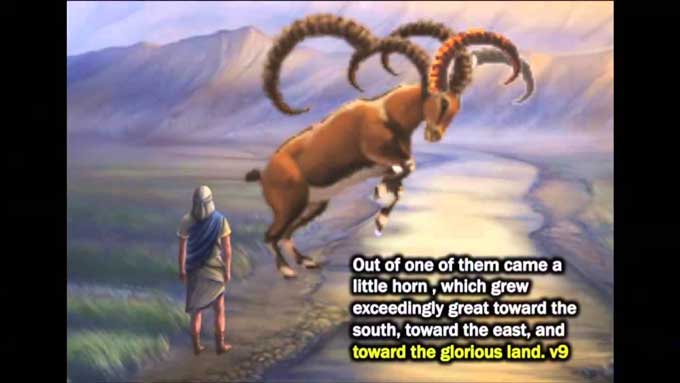
BY PROSPER TINGINI The vision of the Ram and He Goat came to Daniel from God during the third year of King Belshazzar (Daniel 8:1). Nebuchadnezzar’s grandson, Belshazzar, was the last king to reign over the affairs of Babylon (Daniel 5:1-31). His reign was very brief, hence as per God’s prophetic calendar, the final hours of the Empire of Babylon had come.
Details of prophet Daniel’s vision were as follows (Daniel 8:2-8): “And I saw in the vision; and when I saw, I was in Susa the capital, which is in the province of Elam; and I saw in the vision, and I was at the river U’lai. I raised my eyes and saw, and behold, a ram standing on the bank of the river. It had two horns; and both horns were high, but one was higher than the other, and the higher one came up last. I saw the ram charging westward and northward and southward; no beast could stand before him, and there was no one who could rescue form his power; he did as he pleased and magnified himself.
As I was considering, behold, a he-goat came from the west across the face of the whole earth, without touching the ground; and the goat had a conspicuous horn between his eyes. He came to the ram with the two horns, which I had seen standing on the bank of the river and he ran at him in his mighty wrath. I saw him come close to the ram, and he was enraged against him and struck the ram and broke his two horns; and the ram had no power to stand before him, and he cast him down to the ground and trampled upon him; and there was no one who could rescue the ram from his power. Then the he-goat magnified himself exceedingly; but when he was strong, the great horn was broken, and instead of it there came up four conspicuous horns toward the four winds of heaven.”
Daniel 8:15-22 describes how the Lord our God sent His angel Gabriel to explain to Daniel the vision’s meaning. The two horns of the ram represented the Kings of Media and Persia. Daniel describes in his vision that one of the horns was higher than the other, meaning one of the kingdoms was stronger than the other. Of the two kingdoms, history records the fact that the Persian Empire was much stronger than of the Medes. In the vision, Daniel saw the ram pushing westward, northward and southward so that no beasts (i.e. kingdoms and nations) were able to stand before him. Persia and Media geographically located on the east. From the east, the combined forces fought and conquered all the nations that stood in their way to becoming the superpowers of the world. History records that by 539BC the Medo-Persian Empire had risen to become the world’s super-power after defeating the ancient nations of Babylon, Lydia and Egypt.
In the vision, and after witnessing the exploits of the ram, Daniel then saw the appearance of a he-goat. The angel Gabriel went on to clarify the significance and identity of the he-goat. The furious he-goat was a representation of the kingdom of Greece, whose military brilliance was to subsequently and thoroughly overpower the previously dominant nations of Persia and Media. The vision of the he-goat attacking from the sky represents the great speed with which Greece conquered the then civilized world. The notable horn between the eyes of the he-goat was concluded to be representative of the very famous war genius, Alexander the Great. History records the fact that the army of Greece, under the leadership of Alexander the Great, conquered the nations of the then known world at a speed that was unparalleled at the time.
After the he-goat defeated the ram, Daniel saw in the vision that the he-goat became very great and when he was strong, the great horn was broken and in place of it came up four distinct horns pointing towards the four winds of heaven. History records that at the young age of 33 years Alexander is said to have remarked; “There are no more worlds to conquer”. The only conquest he could not do was to conquer himself as the war genius died of a fever due to an excessive intake of alcohol, Alexander requested on his death bed that the kingdom would go to the strongest in the military. This then started a fierce war amongst his generals as they tested their strength against each other.
It was not until the battle of Ipsus in 301B that four of Alexander’s strongest generals divided the empire amongst themselves towards the four winds of the Earth to fulfil Daniels’s vision which reads; “When he was strong (Alexander), the great horn was broken (he died); and from it came four notable ones towards the four winds of heaven” (Daniel 8:8).
These four generals (four horns) were Cassander, who received Greece and its area; Lysimachus, who received Asia-minor; Ptolemy, who received Egypt; and Seleucus, who received Syria and Babylon. A vision fulfilled indeed.
- Chamisa under fire over US$120K donation
- Mavhunga puts DeMbare into Chibuku quarterfinals
- Pension funds bet on Cabora Bassa oilfields
- Councils defy govt fire tender directive
Keep Reading
- Prosper Tingini is the Scribe of the Children of God Missionary Assembly – God’s messengers. Contact details: Mobile and whatsapp: 0771 260 195. Email address: [email protected]











